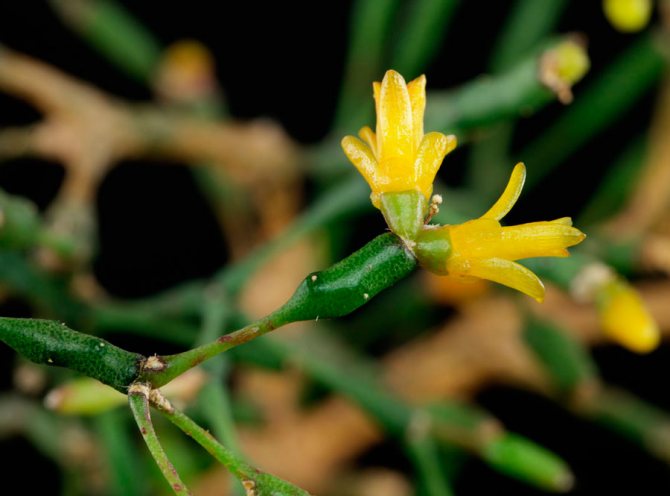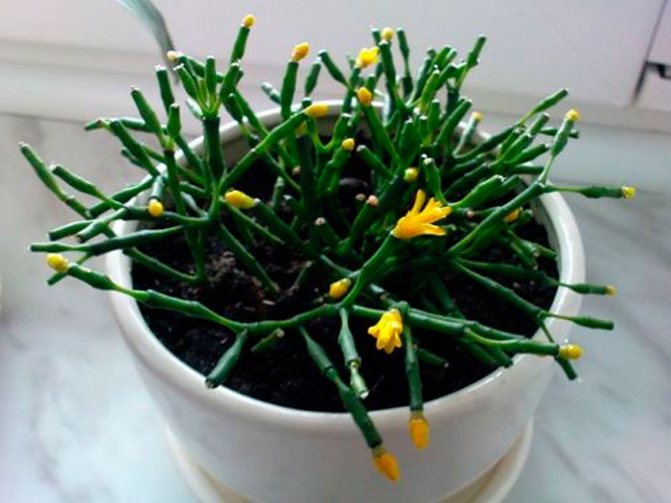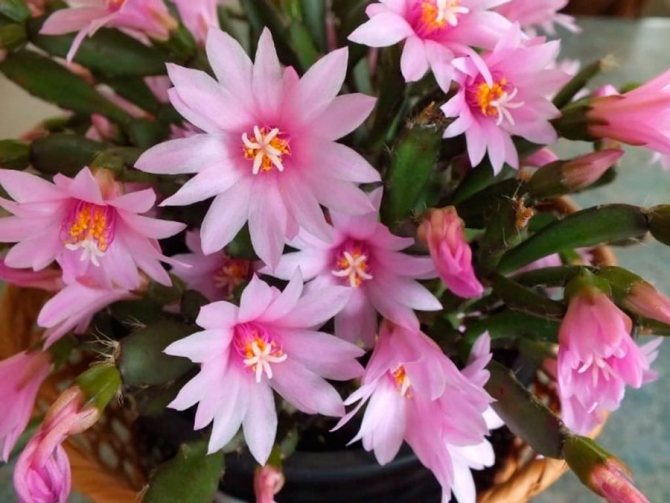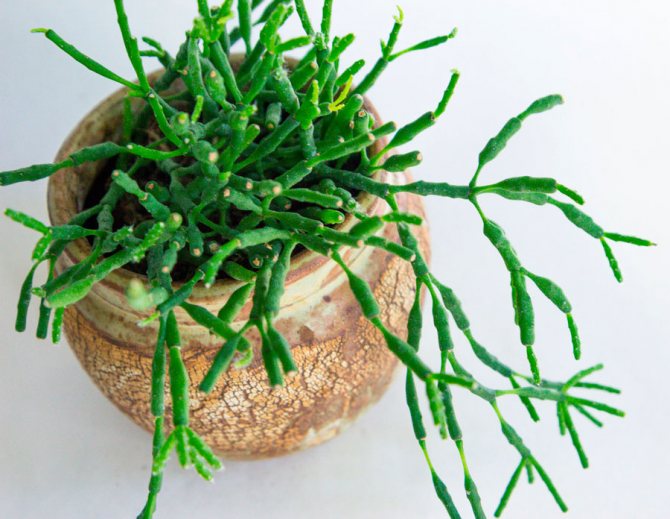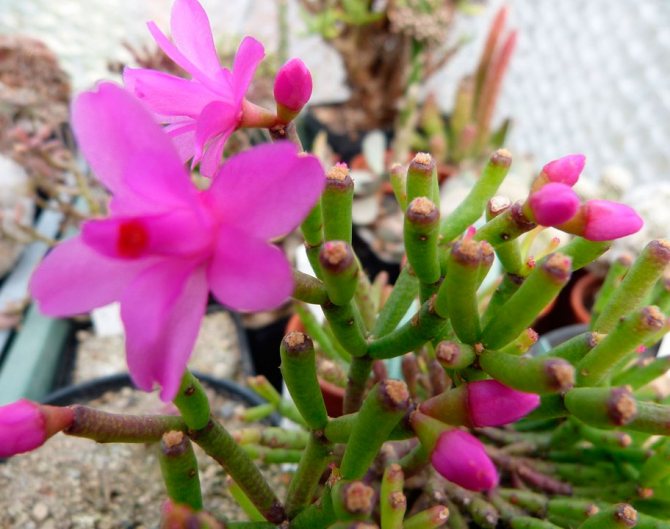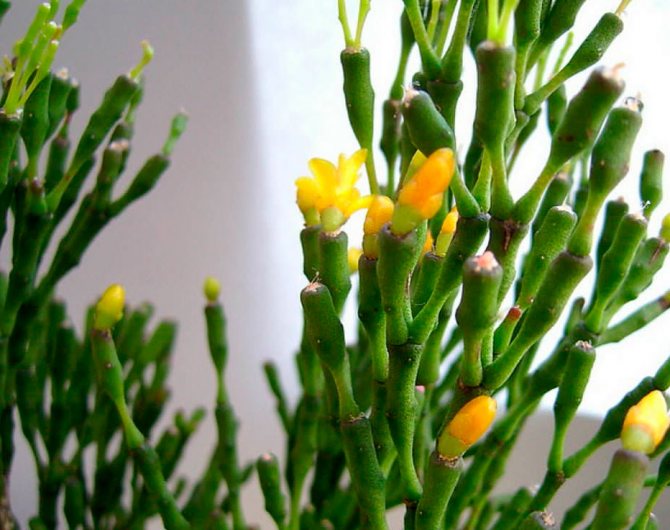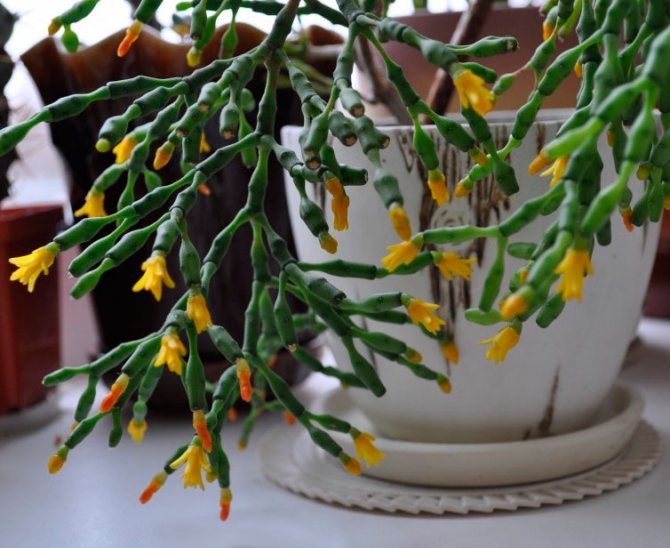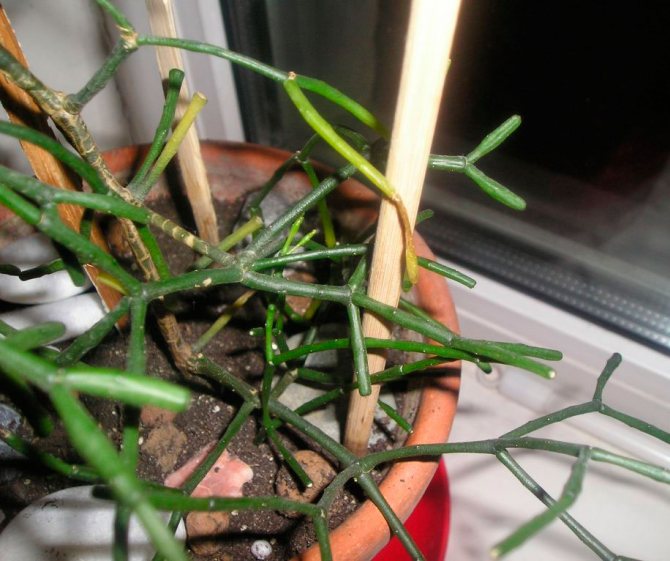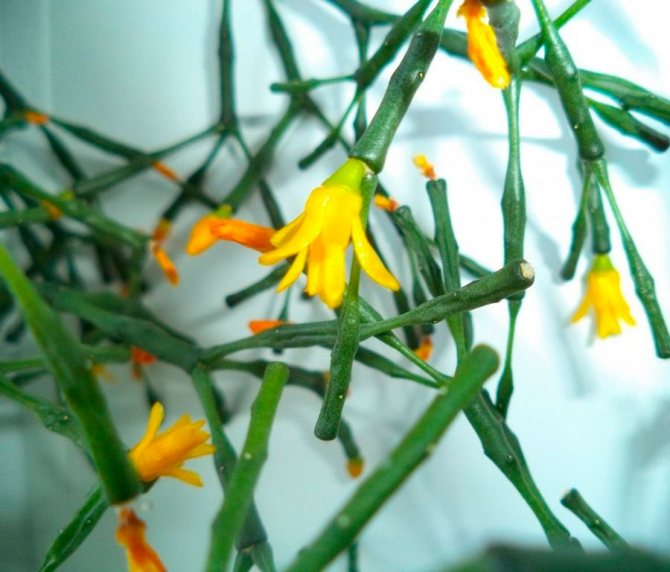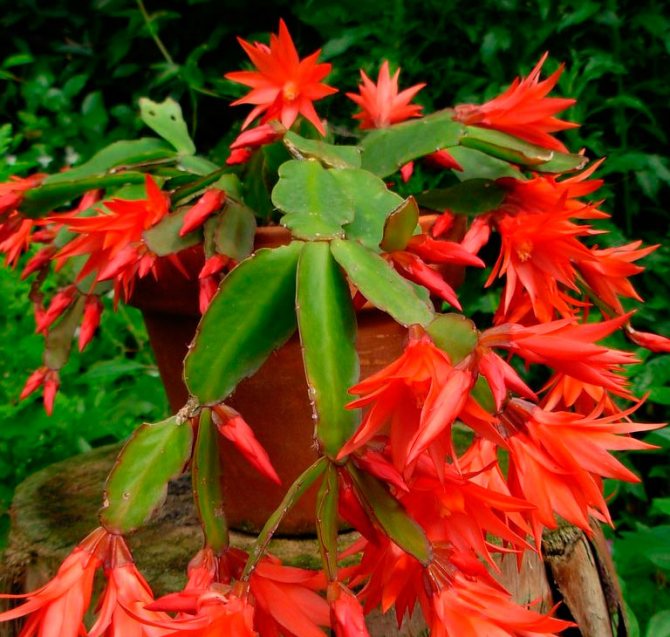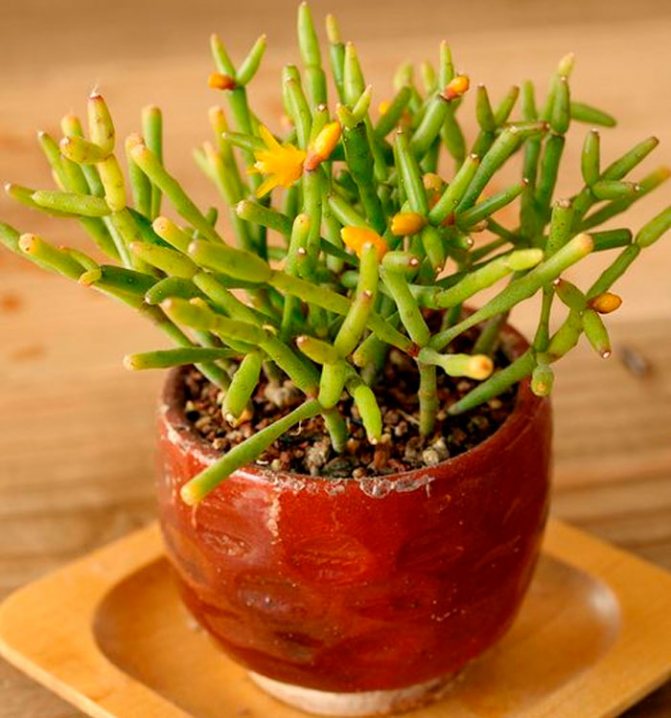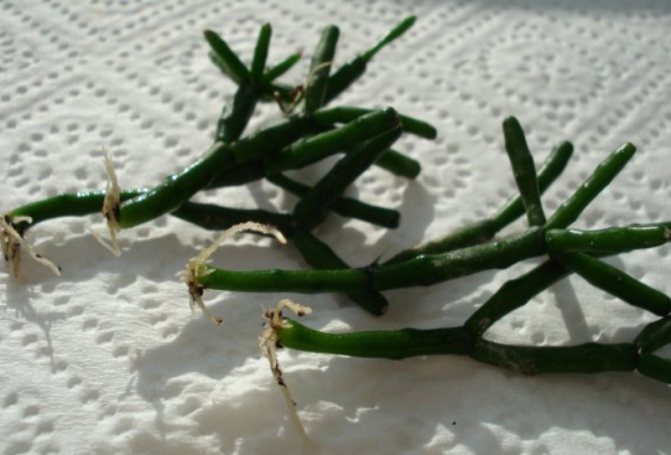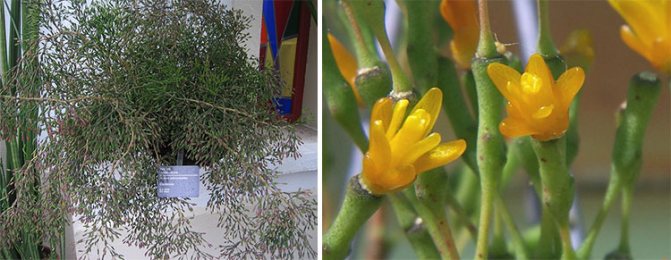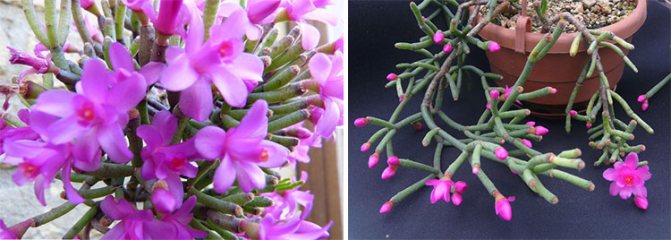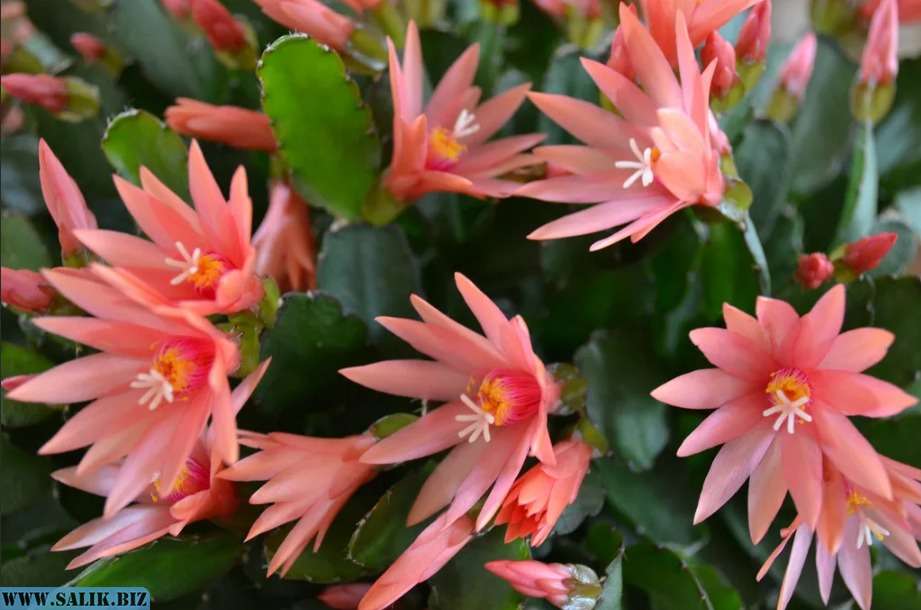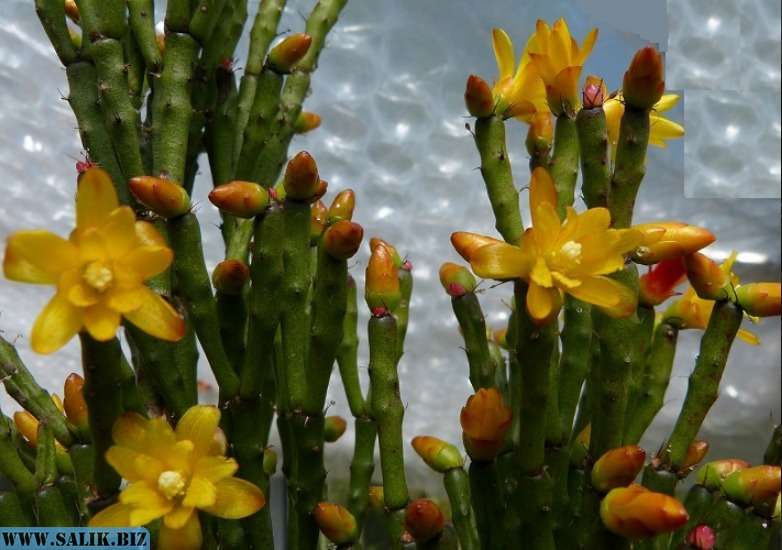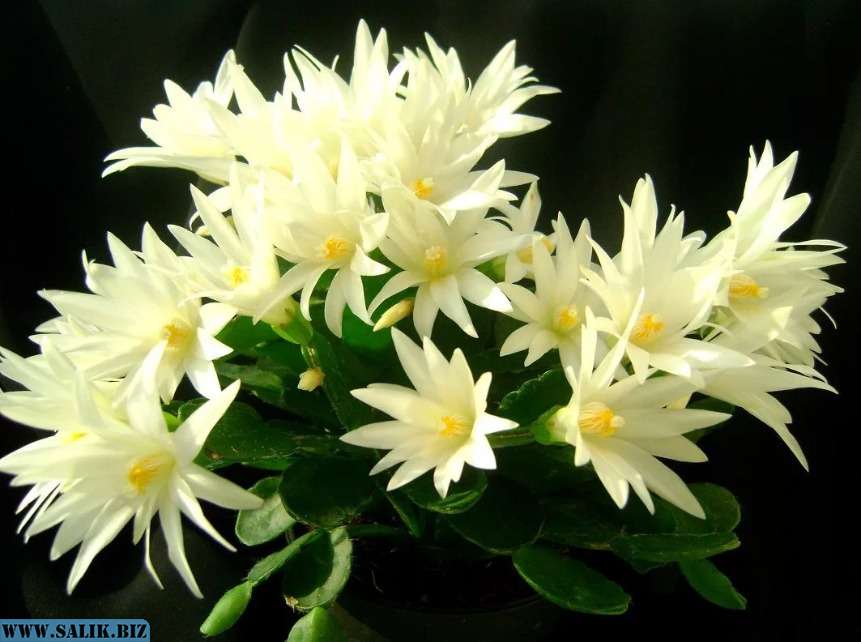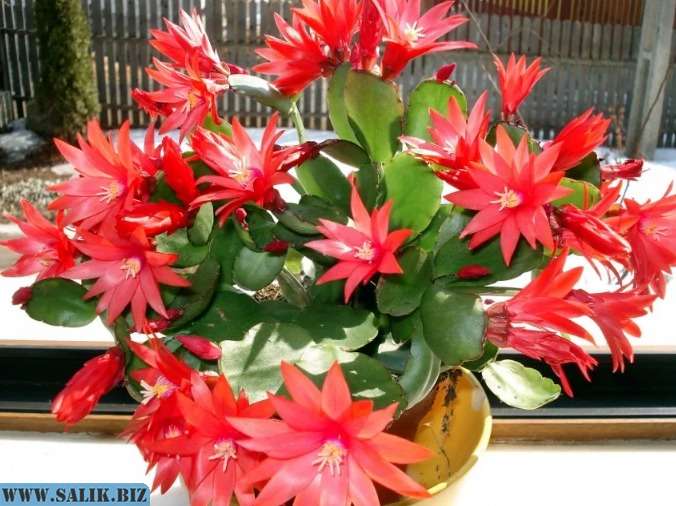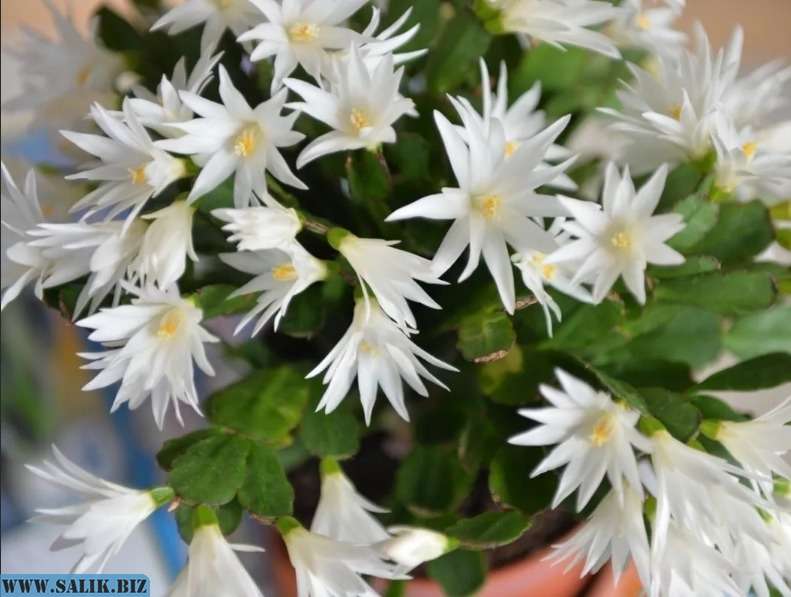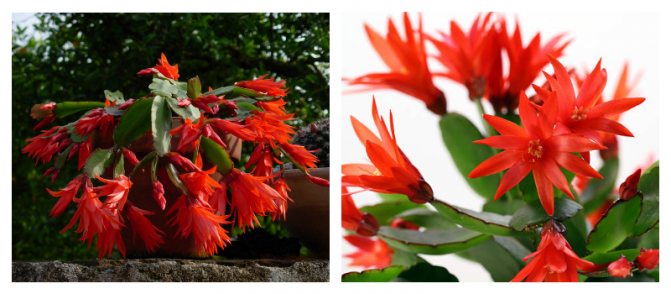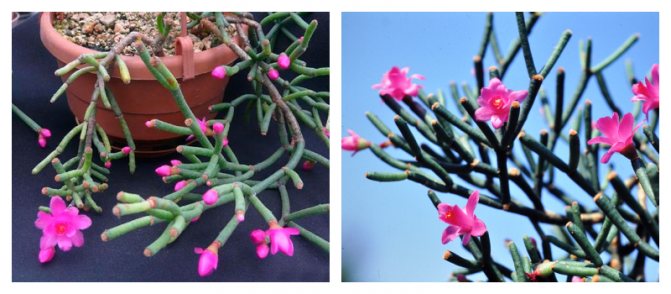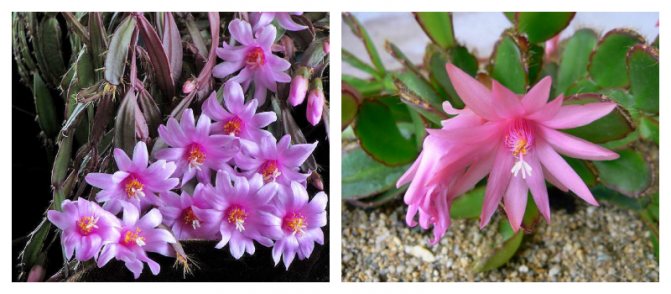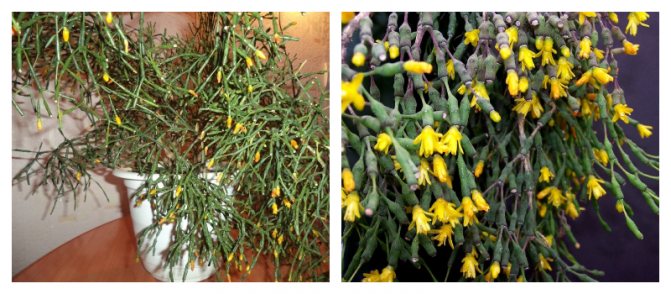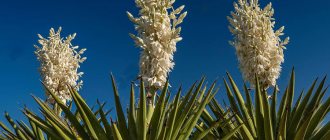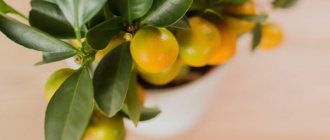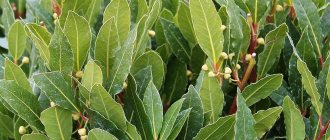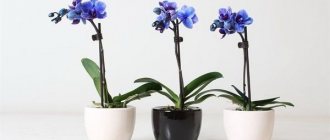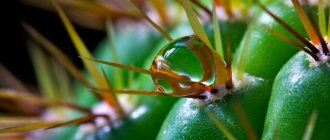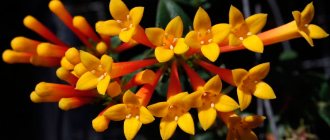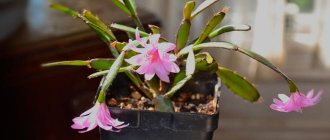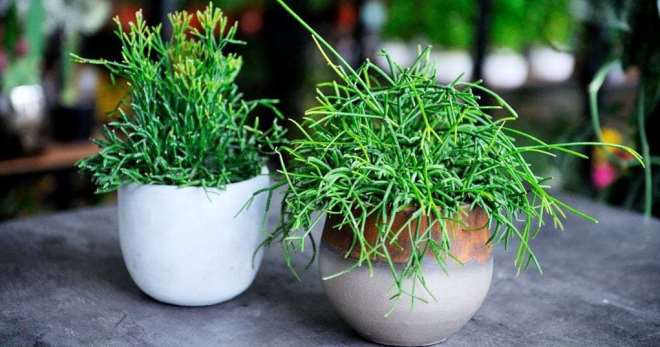
One of the unpretentious indoor succulents is the hatiora. The flower is appreciated for its ability to grow in different conditions and bloom for a long time, mainly in the winter months. The plant has several varieties, differing in the structure and shade of flowers, each of which has its own nuances of care.
Planting and caring for the hatiora
- Bloom: in April or May with red, yellow or pink apical flowers.
- Lighting: bright sunlight, on the southern windowsills - shaded in the afternoon.
- Temperature: in the warm season - 18-25 ˚C, in winter - 12-14 ˚C. The difference between day and night temperatures should be 5-6 degrees.
- Watering: moderate: between two waterings, the top layer of the substrate should dry out. During the rest period, the substrate is moistened less often - about once every 3 weeks. Half an hour after watering, be sure to drain the excess water from the pan.
- Air humidity: it doesn't matter: hatiora is a succulent.
- Top dressing: from spring to autumn, 2 times a month with complex mineral fertilizers that do not contain calcium and with a reduced amount of nitrogen. In the rest of the months, no top dressing is applied.
- Rest period: not pronounced.
- Cropping: to support decorativeness, extra segments are pinched off by hand at the beginning of spring.
- Transfer: in spring, after flowering, at a young age - annually, in mature - once every two to three years, and large specimens - once every five years.
- Reproduction: cuttings and grafting.
- Pests: scale insects, mealybugs and spider mites.
- Diseases: stem rot, late blight.
Read more about growing hatiora below.
general information
Hatiora is an indigenous inhabitant of the rainforests of Brazil, where these shrubs are not uncommon and are found everywhere. It belongs to the genus of epiphytes that develop on trees, but there are also several lithophytic varieties that grow in rocky gorges.
Apartment huts are small bushes, the height of which does not exceed half a meter. Whereas in nature they grow up to a meter.
It is difficult to imagine, but their closest relatives are cacti, and despite the external dissimilarity, there is quite a lot in common between them. Actually, for lovers of cacti and succulents, the cultivation of hatiors does not raise any questions, since these "green pets" require almost the same care.
Hatior flower - description
Hatiora cactus is a shrub with articulated stems. In some species of the genus, the segments are clavate, in others they are cylindrical or flat. What is the difference between hatiora and ripsalis? Under natural conditions, the succulent hatiora grows in crevices of rocks, on stones, while the epiphyte ripsalis prefers to settle in trees. Their external difference lies in the direction of growth of the stems: in the hatiora, they rise up, and in the ripsalis, the shoots are drooping. In addition, in the hatiora, the apical flowers are pink, red or yellow, and in the ripsalis they are located along the entire length of the stem segment and are painted in white or yellowish-white colors. In general, these plants are very close relatives and require the same conditions for keeping.
Dangerous gift
To settle a cactus in an apartment, signs are advised to buy it. But it is extremely undesirable to accept as a gift or give it yourself. It is believed that the gift will lead to a quarrel with the giver.
But the omen can be easily neutralized. To make the gift safe, a little money must be paid for it. The amount is not important. The very fact of payment turns the gift into a purchase, and the negative will thereby be extinguished.
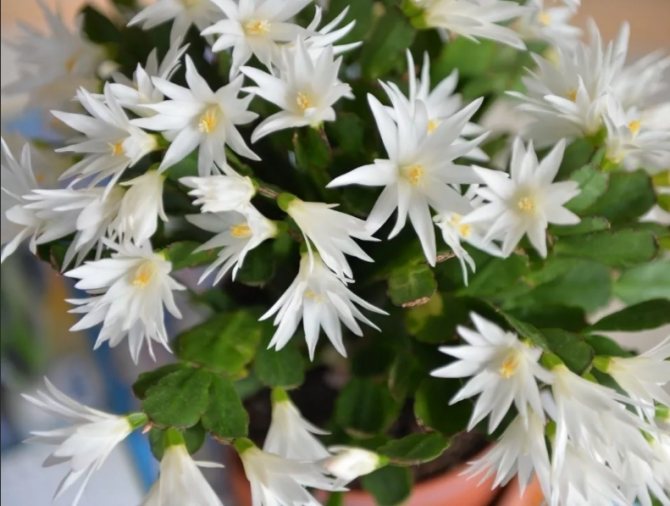

Hatiora care at home
How to care for a hatiora
Caring for a hatiora is simple. But first you need to find a worthy place for her in the house. The hatiora plant will feel great on the windowsills of windows facing the south side, but the plant must be shaded from direct sunlight.
The main condition for the good growth and development of a hatiora is a noticeable difference between day and night temperatures. Hatiore is comfortable at 18-25 ºC. In the summertime, it is advisable to arrange it on the balcony, terrace or in the yard, in the shade of a tree. In winter, in the room where the hatiora flower grows, the temperature should be in the range of 12-14 ºC: it is at this time and in such conditions that flower buds are laid. Hatiora blooms in April or May.
- Pelargonium royal
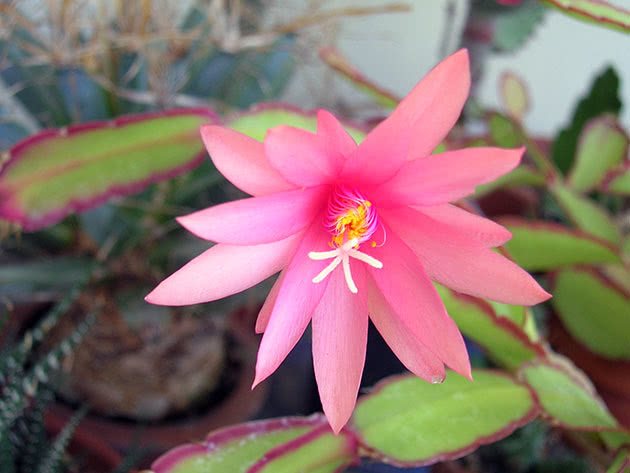

Do not forget to ventilate the room where the plant is located, and in the hot season it must be sprayed, sometimes even twice a day: from the dry air, the stems of the hatiora shrink and wither.
Hatiory pruning, or rather, the formation of the hatiora is carried out manually: the extra segments are simply "unscrewed" from the stem.
Watering the hathiora
Water the hathiora with settled or filtered water at room temperature when the top layer of soil in the pot dries out. During the rest period, watering is carried out less often: about once every three weeks. After half an hour after watering, be sure to drain excess water from the pan. From excess moisture and from watering with cold water, the plant can get sick with root rot.
Top dressing hatiora
During the period of flowering and active growth, the indoor hatiora flower needs fertilizing with a mineral fertilizer that does not contain calcium and with a small amount of nitrogen. The ratio of macronutrients should be as follows: nitrogen - 9, phosphorus - 18, potassium - 24. The frequency of application is 2 times a month. At rest, the plant does not need feeding.
Hatiora transplant
Young plants need an annual transplant, mature hatiors are transplanted once every two years, and large ones - once every five years. Hatiora is transplanted in the spring, after flowering, into a substrate consisting of two parts of leafy soil, one part of coarse sand, one part of sod land and one part of peat with the addition of charcoal. The soil mixture should be neutral or slightly acidic. The pot for the hatiora needs a shallow one. A layer of drainage material is laid on its bottom, then a small layer of substrate, onto which the hatioru is transferred from an old pot. Then the space of the new pot is filled with soil mixture, the surface is lightly pressed and watered.
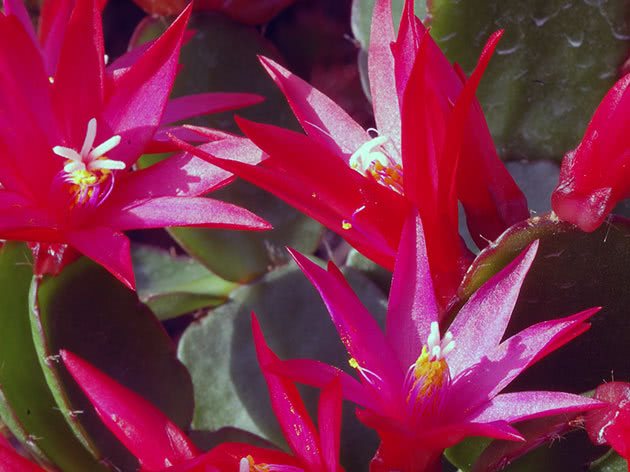

Favorable beliefs
Not all succulent omens are unfavorable. There are also positive ones. Mostly favorable superstitions are associated with the flowering period of the cactus.
- It is popularly believed that it is best to take a succulent home when it is already in bloom. Thus, together with the green resident, the hostess will bring the energy of prosperity, profit, well-being to the house.
- For unmarried girls, the flowering of a cactus means an early marriage, if before that it has not bloomed for a long time.
- Family flowering predicts replenishment: the appearance of a baby. Moreover, it is believed that dark corollas open in anticipation of a boy, and light ones promise a girl.
- Another possible interpretation of the phenomenon for married couples is improving financial well-being, prosperity.
Reproduction of hatiora
Reproduction of hatiora by cuttings
Hatiora at home is easily propagated by cuttings, and each broken off segment of the stem is a potential cuttings, which can itself root directly in the mother's pot.If you want to propagate a hatiora, break off a segment of 3-4 segments after flowering from its stem, sprinkle the wound with crushed charcoal, dry the cutting for 3-5 days, then powder the lower edge with Kornevin and plant the cutting in a moist substrate for cacti. Water the cuttings through the pallet and only after the substrate has completely dried. The next year, a flowering bush is formed from the cuttings with proper care.
- Pelargonium royal
Reproduction of hatiora by grafting
Inoculate the hathiora on peresky prickly. Reproduction of hatiors by grafting is carried out in the summer, removing the branched part of the stock and splitting its trunk. The lower end of the scion cuttings of the hatiors with 2-3 segments are sharpened with a wedge and inserted into the split of the pereskii trunk, after which the graft site is fixed with a plaster. Remove the bandage only after the scion starts to grow. At 18-20 ºC, this can happen in 2-3 weeks. The shoots appearing below the grafting site are removed. Grafted hatiors bloom especially abundantly.
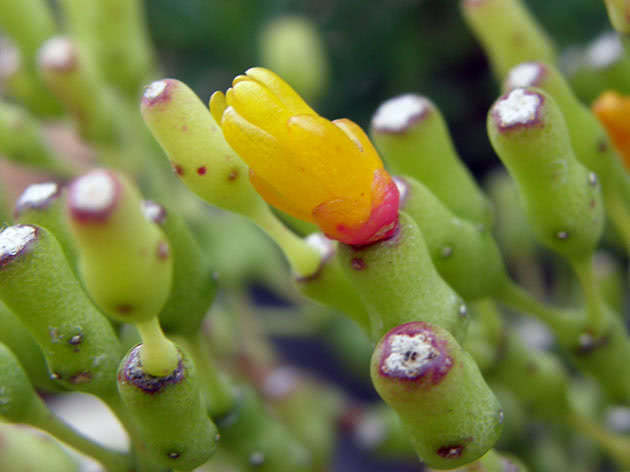

As you can see, breeding and caring for a hatiora is simple and not burdensome.
Diseases and pests of hatiors
Hatiors pests
Hatiora can be attacked by scale insects, mealybugs and spider mites. All these insects are sucking: they make bites in the stems of the hatiora and feed on its cell sap. In the fight against these pests, the plant is treated three times with a solution of acaricide, for example, Fitoverma, Akarin or Agravertine, but first the top layer of the soil is replaced in the pot.
Diseases of the hatior
From chronic waterlogging, the root system of the hatiora can be affected by rot, from which the stem softens and turns brown. If this happens, then the plant can no longer be saved. The best you can do is root the healthy parts of the stems.
Hatiora can get sick with late blight. In this case, the stems of the plant lose color, turn gray, become lethargic and rot. Timely treatment with Oxychom can save the plant.
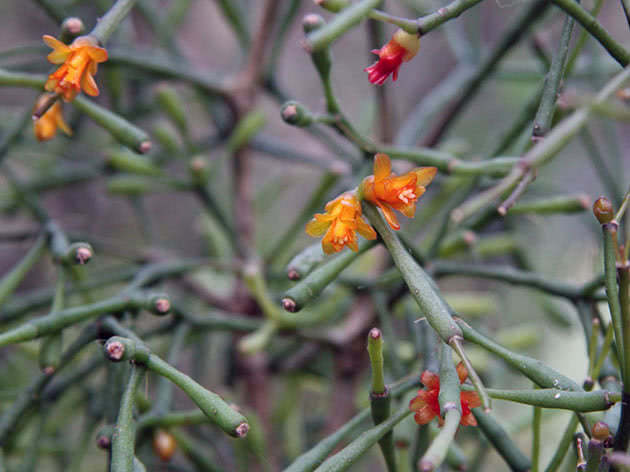

Why hatiora doesn't bloom
If the hatiora does not bloom or forms too few buds, there can be two reasons. First: the pot is small for the plant. Second: improper maintenance of the plant during the dormant period, as a result of which the hatiora was not able to lay flower buds in the required amount. We remind you: the hatiora should overwinter at a temperature not lower than 10 and not higher than 16 ºC, without additional feeding and with minimal watering.
Why does hatiora turn yellow
Hatiory stems turn yellow due to excessive watering or from damage by pests. Examine the plant carefully, determine the cause of its ill health and eliminate it before it is too late.
- Pelargonium royal
Diseases
Among the diseases of the hatiora cactus, the following varieties stand out:
- Bacterial infection. Its presence is indicated by wet and slippery spots that appear on the segments of the stem. Gradually, the stem becomes soft, the leaves fall off, which indicates the severity of the disease. The flower is treated with antibacterial agents. In the absence of the effect of treatment, the bushes are destroyed, but healthy knees are pre-selected, which are rooted and grow a new cactus.
- Fusarium and late blight. They arise with waterlogging of the soil and stagnation of liquid. In case of diseases, the color of the stems fades, the culture fades as a whole. An indoor flower is treated with fungicides. But if it is not possible to get rid of the problems, they act as with a bacterial infection, that is, they completely renew the plant.
Attention! Fungal diseases can appear when transplanted into contaminated soil. Therefore, preliminary steaming (calcination) of the soil is required.
Types and varieties of hatiora
Of all types of hatiors in room culture, the following are grown:
Hatiora salicornioides
or hatiora salicornia, or saliferous, or saltwort - type species of the genus. The stems of this extremely branched plant, which forms a tree about 40 cm high, unlike other types of hatiors, are round in cross section, thin, consisting of pin-shaped segments, for which in England the plant received the nickname "drunkard's dream."In spring, salicata hathiora blooms with small apical pink, red or yellow bell-shaped flowers.
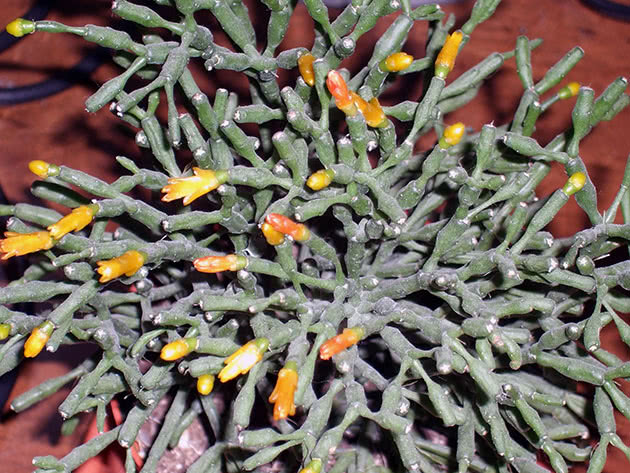

Hatiora rosea
differs from the previous species in green, with a reddish tinge, flat stems of an elliptical or clavate shape. The flowers of this species are large, up to 3-4 cm in diameter, light pink in color.
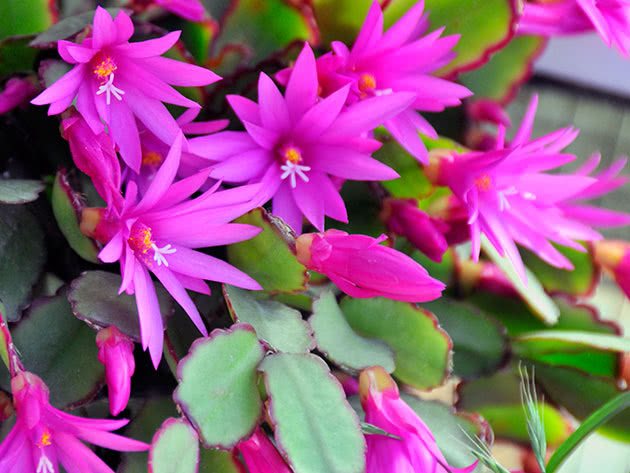

Hatiora herminiae
- an epiphytic cactus with crimson flowers and straight or arcuate stems up to 30 cm long, consisting of dark green, cylindrical in cross-section segments from 2 to 5 cm long and 5 mm in diameter.
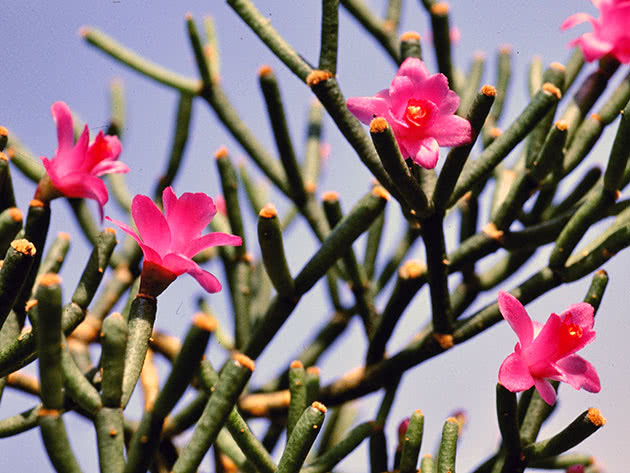

Hatiora gaertneri
- the segments of the stems of this plant with small notches at the edges, reach a length of 7 cm.The flowers of Gartner's hatior are funnel-shaped, scarlet-red, up to 5 cm in diameter.
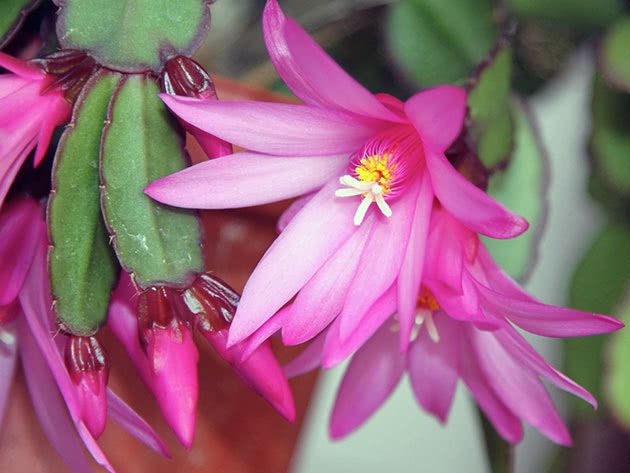

Hatiora graeseri
- a hybrid view between the rose hathiora and the Gartner haciora. The flower petals of this hybrid are painted in red-burgundy tones, but other shades began to appear in the process of reclamation.


Hatiora pentaptera
- a plant with pentahedral stems and small white flowers, resembling a shrub.

